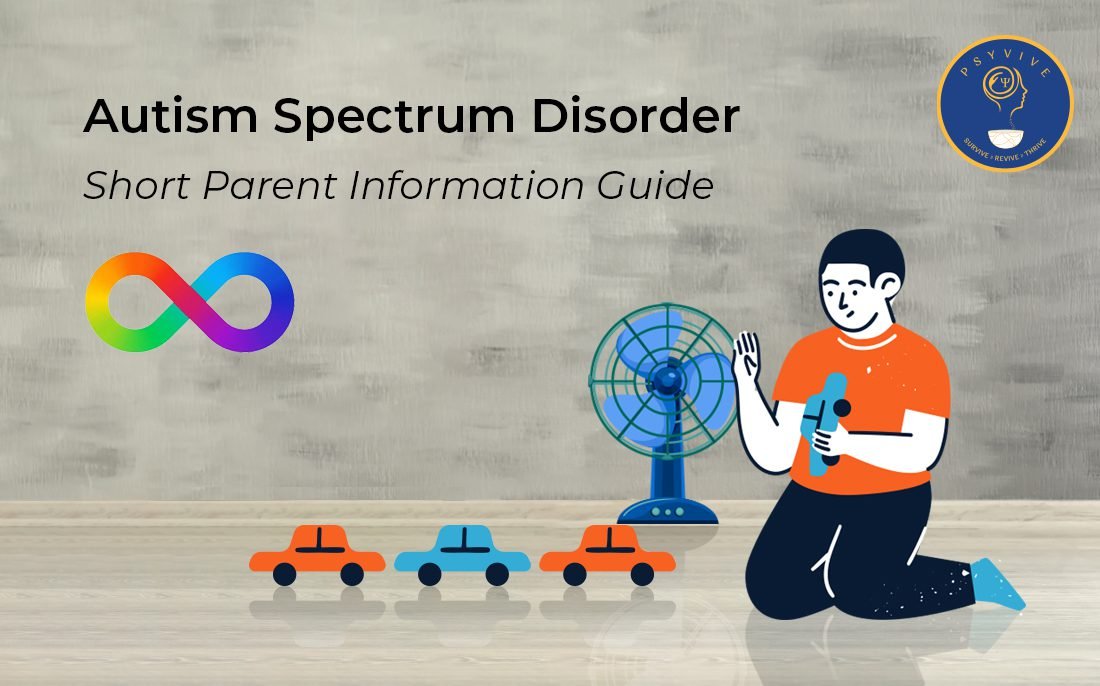Autism Spectrum Disorder: Short Parent Information Guide

Autism Spectrum Disorder (ASD)/ Autism is a neurodevelopmental disorder. Meansit is related to how the young one’s brain develops and functions from the womb, to childhood and beyond.
Features may start before age three.
Mainly, three areas are affected in ASD–
- Social interaction
- Communication
- Restricted – repetitive behaviour
What you may see: –
Relating to people
- Avoids eye contact or seems aloof
- Resists or avoids social interaction
- May be overly shy or fussy when encouraged to interact
Imitation
- Difficulty imitating sounds, words, or actions
- Often needs repeated prompting to imitate, or may rarely imitate
Emotions:
- Expresses emotions in ways that donot match the situation (e.g. laughing or smiling without a clear context)
- Has trouble recognising or interpreting others’ emotions
- May not respond appropriately to emotional cues
Speech:
- Retardation in speech-
- Echolalia (simply repeating what is told/asked to them), pronoun reversals (says you or she/he instead of I. e.g. “You want teddy” instead of “I want teddy”).
- Use jargon excessively, unusual use of words, or fixates on specific topics
- Some may make repeated sounds rather than speaking.
Nonverbal communication:
- Cannot point or point vaguely
- Unable to use nonverbal gestures.
- Difficulty in understanding and responding to others’ nonverbal communication.
Difficulty in comprehending and responding appropriately to verbal and non-verbal communication
Difficulty adjusting behaviour according to social context
Repetitive, restricted, or stereotyped patterns of behaviour, interests, and activities
Movement:
- May appear clumsy or poorly coordinated
- Shows repetitive movements (e.g., rocking, spinning, hand flapping, finger wiggling, toe walking)
- Engages in unusual body postures or self-stimulatory behaviour (e.g., picking at skin, staring at body parts)
- May hurt themselves
Object use:
- Plays with toys in unusual ways (e.g., banging, sucking, or focusing on one part of a toy, line up toys often)
- May show little interest in toys but isvery fascinated by everyday objects (e.g. fan rotating, washing machine rotating, spinning objects, wheel rotating, bin lid, utensils)
- Might prefer light reflections or spinning parts over functional use of toys
Routine:
- Strong preference for sameness in daily routines and environments
- May not adjust to even minor changes and could react and resist strongly
Vision:
- Needs a lot of prompting to look at people or objects, may avoid looking
- May stare into space or focus intensely on lights, mirrors, or small details
- Looks at objects from unusual angles or holds them very close to the eyes
Listening:
- Overreacts or underreacts to sounds
- Might cover ears in response to ordinary noises
- Easily distracted by background sounds
Taste, Smell, and Touch
- Often explores objects by mouthing, smelling, or tasting more than looking
- May smell or lick inedible items or people
- Shows unusual responses to pain—too little reaction ortoo intense a response
Fear and Safety
- Displays either a lack of fear or extreme, unmanageable fear
- Some may have difficulty recognising danger
Activity Levels
- May be extremely hyperactive or unusually inactive
- Some children may alternate between these extremes